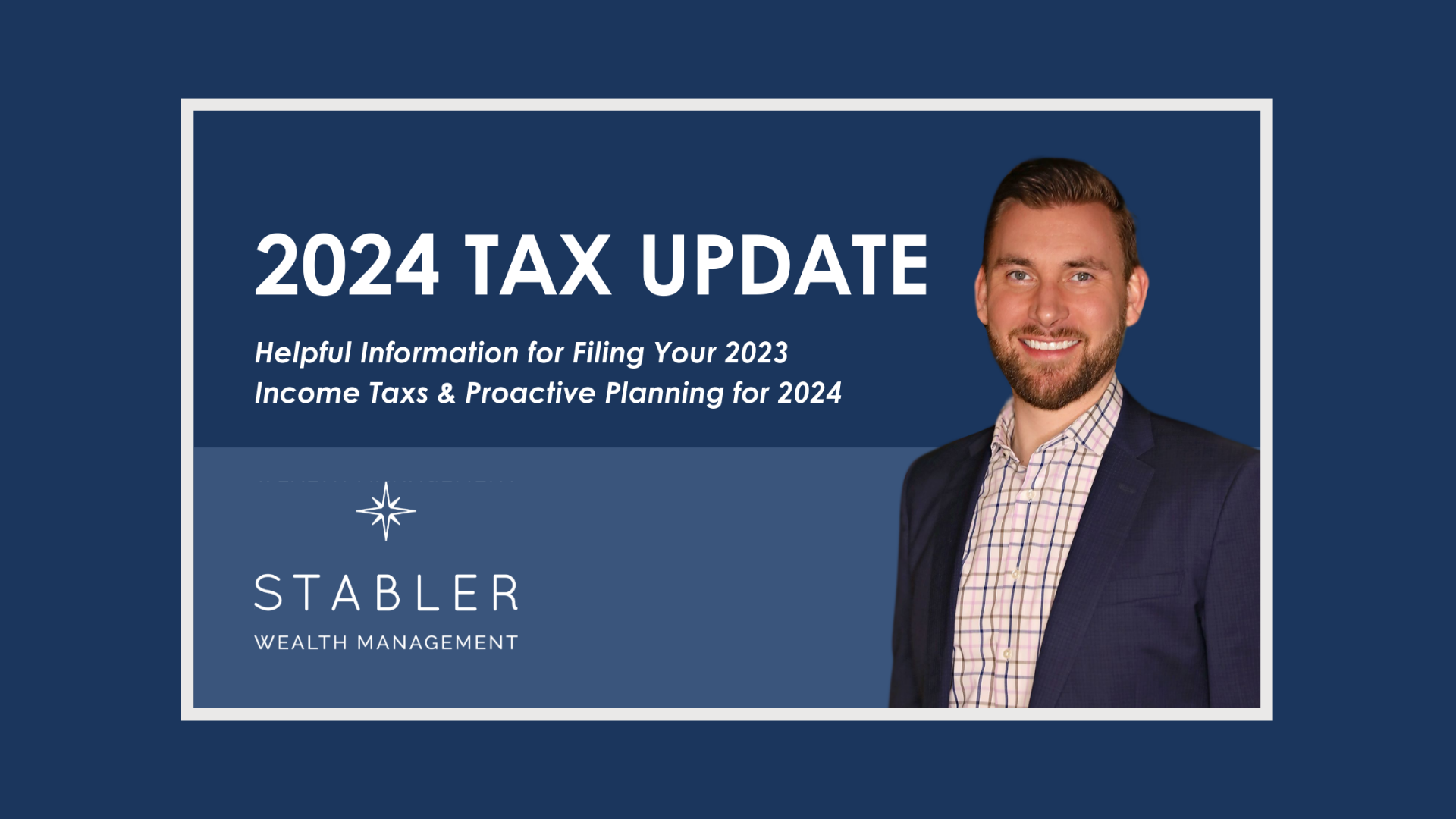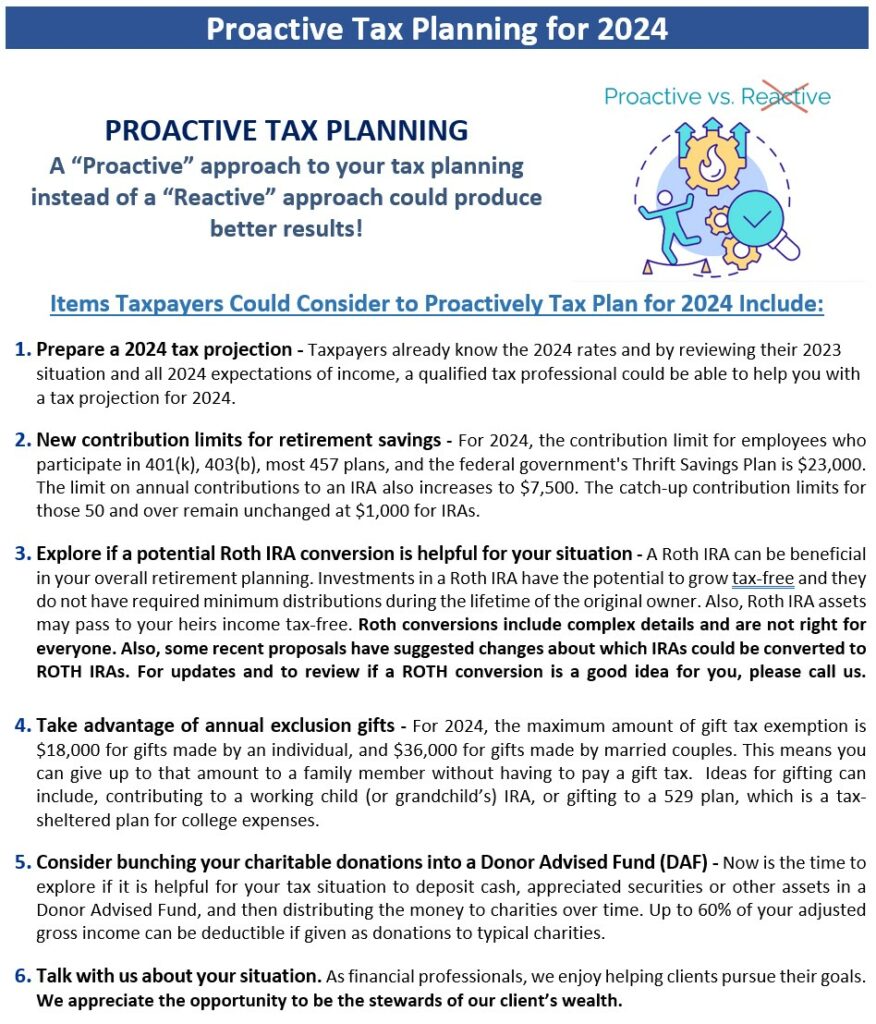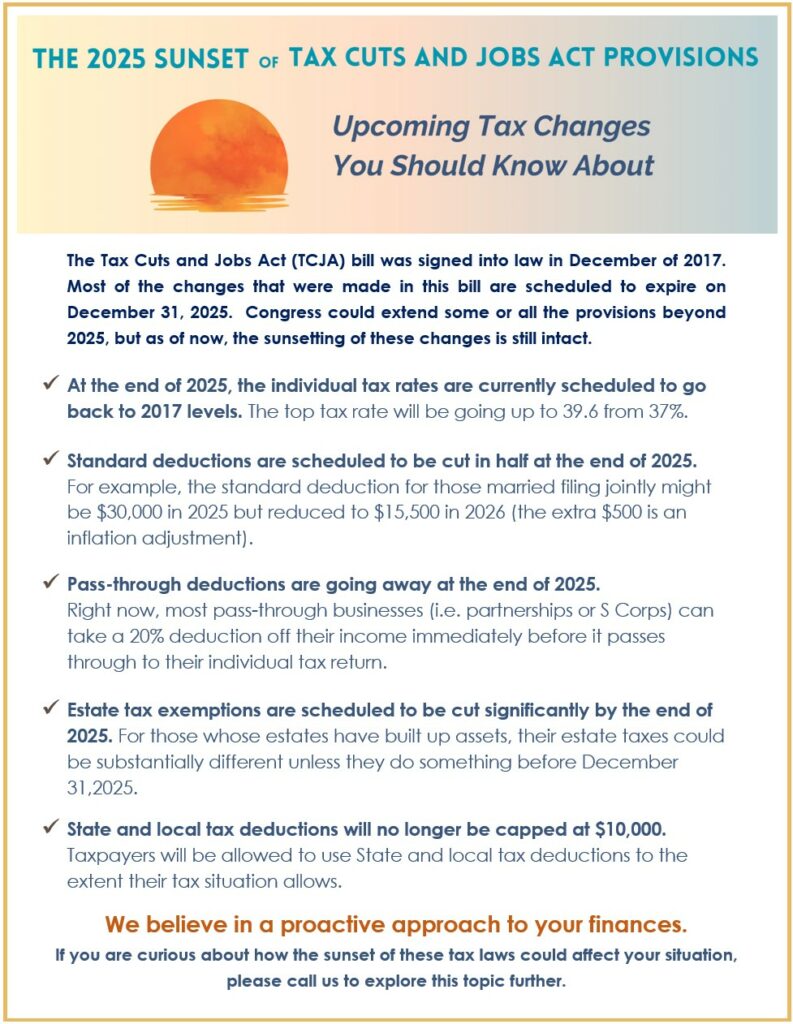2024 Tax Update: Helpful Information for Filing 2023 Income Taxes and Proactive Tax Planning for 2024


Income tax is a large revenue source for the United States government. While tax rates have changed many times, since the 1860’s, the United States has used a “progressive” tax code. A progressive tax code means that people who make more money are taxed at a higher rate than those who make less money. Our progressive tax system works by placing earners through different brackets according to how much money they make. The dollar amounts define your tax brackets and there are differing tables depending on your filing status (single, married, etc.). This matters in determining your marginal tax rate.
Understanding Marginal Tax Rates
Determining your tax bracket is not as simple as just adding up your total income and checking a tax table. Taxpayers need to calculate their income (which can be sometimes referred to as their “adjusted gross income”) and then adjust for any deductions to find their final taxable amount.
Once you determine your taxable income amount, it is critical to know that your income will be taxed at different rates. For example, if someone is married filing jointly in 2023 with $95,000 of taxable income, their first $22,000 is taxed at 10%, the $67,450 at 12%, and $5,550 at 22%. An important concept to understand is that these same tax filers are in a “marginal tax bracket” of 22%. That is, their last dollar earned is taxed at that 22% tax rate.
2023 Tax Law Updates
2023 brought some tax legislation changes. While there is time to investigate tax planning ideas for your 2024 taxes, here are some items that 2023 tax filers should review.
- Tax brackets have been slightly adjusted.
- Standard deductions have slightly increased.
- The cap on state and local tax (SALT) deductions remains.
- Long-term capital gains are still taxed at favorable rates.
- There is still a 3.8% Net Investment Tax.
- Charitable donations are available to those who can itemize deductions.
- You might still be able to contribute to retirement plans.
- Medical expense deductions are capped at 7.5% of AGI for 2023.

2023 Tax Tables and Tax Rates
There are still seven federal income tax brackets for 2023. The lowest of the seven tax rates is 10% and the top tax rate is still 37%. The income that falls into each is scheduled to be adjusted in 2024 for inflation. For 2023, use the chart in this report to see what bracket your final income falls into.
TAX TIP: If you are not sure how best to file, ask your tax preparer or review IRS Publication 17, Your Federal Income Tax, which is a complete tax resource. It contains helpful information such as whether you need to file a tax return and how to choose your filing status.
2023 Standard Deduction Amounts
Most taxpayers claim the standard deduction. For 2023, the standard deduction has slightly increased. The amounts are now $13,850 for single filers and $27,700 for those filing jointly ($20,800 for head of household filers). If you are filing as a married couple, an additional $1,500 is added to the standard deduction for each spouse age 65 and older or blind. If you are single, an additional deduction of $1,850 can be made.
Increased Child Tax Credit
The American Rescue Plan Act (ARPA) extended the increased Child Tax Credit (CTC) for the tax year of 2021 only. For 2021, the child tax credit for children under 6 years old was $3,600, and for children 6-17, it was $3,000. Starting in 2022, the credit reverted back to the rules in the Tax Cuts and Jobs Act (TCJA), with a maximum tax credit of $2,000 for each qualifying child.
State and Local Taxes (SALT) Deduction
Under the 2017 Tax Cuts and Jobs Act (TCJA) state and local tax deductions (SALT) remain capped at a combined total of $10,000 (or $5,000 for married taxpayers filing separately). This deduction limitation is set to sunset at the end of 2025.
Medical Expense Deduction
The 2023 threshold for deducting medical expenses remains 7.5% of your AGI. You must itemize your deductions to deduct these medical expenses. The IRS website, www.IRS.gov, provides a long list of expenses that qualify as “medical expenses” so it can be a good idea to keep track of yours if you think they may qualify.
Investment Income
Long-term capital gains are taxed at more favorable rates compared to ordinary income. For qualified dividends, investors will continue to be taxed at 0, 15% or 20%.
One tax strategy is to review your investments that have unrealized long-term capital gains and sell enough of the appreciated investments to generate enough long-term capital gains to push you to the top of your federal income tax bracket. This strategy could be helpful if you are in the 0% capital gains bracket and do not have to pay any federal taxes on this gain. Then, if you want, you can buy back your investment the same day, increasing your cost basis in those investments. If you sell them in the future, the increased cost basis will help reduce long-term capital gains. You do not have to wait 30 days before you buy back this investment—the 30-day rule only applies to losses, not gains.
Note: This non-taxable capital gain for federal income taxes might not apply to your state.
TAX TIP: Remember that marginal tax rates on long-term capital gains and dividends can be higher than expected. The 3.8% surtax can raise the effective rate to 18.8% for single filers with income from $200,000 to $492,300 and 23.8% for single filers with income above $492,300 in 2023. It can raise the effective rate to 18.8% for married taxpayers filing jointly with income from $250,000 to $553,850 and to 23.8% for married taxpayers filing jointly with income above $553,850.

Calculating Capital Gains and Losses
With the different tax rates for different types of gains and losses in your marketable securities portfolio, it is probably a good idea to familiarize yourself with some of the ordering rules:
- Short-term capital losses must first offset short-term capital gains.
- Long-term capital losses must first offset long-term capital gains.
- If there are net short-term losses, they can be used to offset net long-term capital gains.
- If there are net long-term losses, they can be used to offset net short-term capital gains.
- If all gains and losses net to an overall loss, up to $3,000 can offset ($1,500 if married filing separately) ordinary income.
- Remaining unused capital losses can be carried forward to later tax years and then considered in the same manner as described above.
TAX TIP: Please remember to look at your 2022 income tax return Schedule D (page 2) to see if you have any capital loss carryover for 2023. This is often overlooked, especially if you are changing tax preparers.
Please double-check your capital gains or losses. If you sold an asset outside of a qualified account during 2023, you most likely incurred a capital gain or loss. Sales of securities showing the transaction date and sale price are listed on the 1099 generated by the financial institution. However, your 1099 might not show the correct cost basis or realized gain or loss for each sale. You will need to know the full cost basis for each investment sold outside of your qualified accounts, which is usually what you paid for it, but this is not always the case.
| 2023 Long Term Capital Gains Tax Rates | |||
| Tax Rate | Single Filer | Head of Household | Married Filers |
| 0% | $44,625 or less | $59,750 or less | $89,250 or less |
| 15% | $44,626 – $492,300 | $59,751 – $523,050 | $89,251 – $553,850 |
| 20% | Over $492,301 | Over $523,051 | Over $553,851 |
3.8% Medicare Investment Tax
The year 2023 is the eleventh year of the net investment income tax of 3.8%. It is also known as the Medicare surtax. If you earn more than $200,000 as a single or head of household taxpayer, $125,000 as married taxpayers filing separately or $250,000 as married joint return filers, then this tax applies to either your modified adjusted gross income or net investment income (including interest, dividends, capital gains, rentals, and royalty income), whichever is lower. This 3.8% tax is in addition to capital gains or any other tax you already pay on investment income.
It is helpful to pay attention to timing, especially if your income fluctuates from year to year or is close to the $200,000 or $250,000 amount. Consider realizing capital gains in years when you are under these limits. The inclusion limits may penalize married couples, so realizing investment gains before you tie the knot may help in some circumstances. This tax makes the use of depreciation, installment sales, and other tax deferment strategies suddenly more attractive.
Medicare Health Insurance Tax on Wages
If you earn more than $200,000 in wages, compensation, and self-employment income ($250,000 if filing jointly, or $125,000 if married and filing separately), the Affordable Care Act levies a special additional 0.9% tax on your wages and other earned income. You’ll pay this all year as your employer withholds the additional Medicare Tax from your paycheck. If you’re self-employed, plan for this tax when you calculate your estimated taxes.
If you’re employed, there’s little you can do to reduce the bite of this tax. Requesting non-cash benefits in lieu of wages won’t help—they’re included in the taxable amount. If you’re self-employed, you may want to take special care in timing income and expenses (especially depreciation) to avoid the limit.
Charitable Gifts and Donations
In 2023, the rules return to the previous requirements that taxpayers can only deduct charitable contributions if they itemize their tax deductions on Schedule A. Through 2025, the 60% of AGI ceiling on charitable cash contributions remains unchanged but is scheduled to revert to 50% thereafter.
To qualify for the 60% limitation, the charitable gift must be cash (or cash
equivalent) made to a qualified charity (501(c)(3)). To qualify, this contribution should have been made on or before December 31, 2023.
When preparing your list of charitable gifts, remember to review your bank account so you do not leave any out. Everyone remembers to count the monetary gifts they make to their favorite charities, but you should count noncash donations as well. Make it a priority to always get a receipt for every gift. Keep your receipts. If your contribution totals more than $250, you will also need an acknowledgement from the charity documenting the support you provided. Remember that you will have to itemize to claim this deduction, but when filing, the expenses incurred while doing charitable work often are not included on tax returns.
You can’t deduct the value of your time spent volunteering, but if you buy supplies for a group, the cost of that material is deductible as an itemized charitable donation. You can also claim a charitable deduction for the use of your vehicle for charitable purposes, such as delivering meals to the homebound in your community or taking your child’s Scout troop on an outing. For 2023, the IRS will let you deduct that travel at .14 cents per mile.
Child and Dependent Care
Millions of parents claim the child and dependent care credit each year to help cover the costs of after-school daycare while working. Some parents overlook claiming the tax credit for childcare costs during the summer. This tax break can also apply to summer day camp costs. The key is that for deduction purposes, the camp can only be a day camp, not an overnight camp.
In 2023, if you paid a daycare center, babysitter, summer camp, or other care provider to care for a qualifying child under age 17 or a disabled dependent of any age, depending on your income you may qualify for a tax credit of up to 50% of qualifying expenses of $2,000 for one child or dependent, or up to $6,000 for two or more children.
Contribute to Retirement Accounts
The SECURE Act allowed people with earned income to make contributions to Traditional IRAs past the age of 70½ starting in 2020.
If you have not already funded your retirement account for 2023, consider doing so by Monday, April 15, 2024. That’s the deadline for contributions to a traditional IRA (deductible or not) and a Roth IRA. However, if you have a Keogh or SEP and you get a filing extension by October 15, 2024, you can wait until then to put 2023 contributions into those accounts. To start tax-advantaged growth potential as quickly as possible, however, try not to delay in making contributions. If eligible, a deductible contribution will help you lower your tax bill for 2023 and your contributions can grow tax deferred.
To qualify for the full annual IRA deduction in 2023, you must either: 1) not be eligible to participate in a company retirement plan, or 2) if you are eligible, there is a phase-out from $73,000 to $83,000 of MAGI for singles and from $116,000 to $136,000 for married taxpayers filing jointly. If you are not eligible for a company plan but your spouse is, your traditional IRA contribution deduction is phased out from $218,000 to $228,000. For 2023, the maximum IRA contribution you can make is $6,500 ($7,500 if you are age 50 or older by the end of the calendar year). For self-employed persons, the maximum annual addition to SEPs and Keoghs for 2023 is $66,000.
Although contributing to a Roth IRA instead of a traditional IRA will not reduce your 2023 tax bill (Roth contributions are not deductible), it could be the better choice because all qualified withdrawals from a Roth can be tax-free in retirement. Withdrawals from a traditional IRA are fully taxable in retirement. To contribute the full $6,500 ($7,500 if you are age 50 or older by the end of 2023) to a Roth IRA, you must have MAGI of $138,000 or less a year if you are single or $218,000 if you are married and file a joint return. If you have any questions on retirement contributions, please call us.
| Retirement Plan | 2023 Limit |
| Elective deferrals to 401(k), 403(b), 457(b)(2), 457(c)(1) plans | $22,500 |
| Contributions to defined contribution plans | $66,000 |
| Contributions to SIMPLEs | $15,500 |
| Contributions to traditional IRAs | $6,500 |
| Catch-up Contributions to 401(k), 403(b), 457(b)(2), 457(c)(1) plans | $7,500 |
| Catch-up Contributions to SIMPLEs | $3,500 |
| Catch-up Contributions to IRAs | $1,000 |
Roth IRA Conversions
A Roth IRA conversion is when you convert part or all of your traditional IRA into a Roth IRA. This is a taxable event. The amount you converted is subject to ordinary income tax. It might also cause your income to increase, thereby subjecting you to the Medicare surtax. Roth IRAs grow tax-free and qualified withdrawals are tax-free in the future, a time when tax rates might be higher.
Whether to convert part or all of your traditional IRA to a Roth IRA depends on your particular situation. It is best to prepare a tax projection and calculate the appropriate amount to convert. Remember—you do not have to convert all of your IRA to a Roth. Roth IRA conversions are not subject to the pre-age 59½ penalty of 10%.
Many 401(k) plan participants (if their plan allows) can convert the pre-tax money in their 401(k) plan to a Roth 401(k) plan without leaving the job or reaching age 59½. There are numerous pros and cons to making this change. Please call us to see if this makes sense for you.
Required Minimum Distributions (RMD)
The SECURE Act increased the age for Required Minimum Distributions (RMD) starting January 1, 2020, to age 72. The most recent SECURE 2.0 Act increased the age to start taking RMDs further, to 73 in 2023 and to 75 in 2033.
The purposes of tax year 2023, the Required Minimum Distributions age is 73.
Other Overlooked Tax Items and Deductions
Reinvested Dividends – This is not a tax deduction, but it is an important calculation that can save investors a bundle. Former IRS commissioner Fred Goldberg told Kiplinger magazine for their annual overlooked deduction article that missing this break costs millions of taxpayers a lot in overpaid taxes.
Many investors have mutual fund dividends that are automatically used to buy extra shares. Remember that each reinvestment increases your tax basis in that fund. That will, in turn, reduce the taxable capital gain (or increases the tax-saving loss) when you redeem shares. Please keep good records. Forgetting to include reinvested dividends in your basis results in double taxation of the dividends—once in the year when they were paid out and immediately reinvested and later when they are included in the proceeds of the sale.
If you are not sure what your basis is, ask the fund or us for help. Funds often report to investors the tax basis of shares redeemed during the year. Regulators currently require that for the sale of shares purchased, financial institutions must report the basis to investors and to the IRS.
Student-Loan Interest Paid by Parents – Generally, you can deduct interest only if you are legally required to repay the debt. But if parents pay back a child’s student loans, the IRS treats the transactions as if the money were given to the child, who then paid the debt. So as long as the child is no longer claimed as a dependent, the child can deduct up to $2,500 of student-loan interest paid by their parents each year and is subject to income limitations. (The parents can’t claim the interest deduction even though they actually foot the bill because they are not liable for the debt).
Helpful Tax Time Strategies
- Write down expenses or keep all receipts you think are even possibly tax-deductible. Sometimes, taxpayers assume that various expenses are not deductible and therefore do not mention them to their tax preparer. Don’t assume anything—give your tax preparer the chance to tell you whether something is or is not deductible.
- Be careful not to overpay Social Security taxes. If you received a paycheck from two or more employers and earned more than $160,200 in 2023 you may be able to file a claim on your return for the excess Social Security tax withholding.
- Don’t forget items carried over from prior years because you exceeded annual limits, such as capital losses, passive losses, charitable contributions, and alternative minimum tax credits.
- Check your 2022 tax return to see if there was a refund from 2022 applied to 2023 estimated taxes.
- Calculate your estimated tax payments for 2024 very carefully. Many computer tax programs will automatically assume that your income tax liability for the current year is the same as the prior year. This is done to avoid paying penalties for underpayment of estimated income taxes. However, in some cases this might not be a correct assumption, especially if 2023 was an unusual income tax year due to the sale of a business, unusual capital gains, the exercise of stock options, or even winning the lottery! A qualified tax professional should be able to help you with a tax projection for 2024.
- Remember that IRS.gov could be a valuable online resource for tax information.
- Always double check your math where possible and remember it is always wise to consult a tax preparer before filing.


Conclusion
Filing your 2023 taxes will continue to include the new tax rates set forth with the Tax Cuts and Jobs Act (TCJA) enacted in 2018 (currently set to expire after 2025). An essential part of maintaining your overall financial health is attempting to keep your tax liability to a minimum.
One of our primary goals is to keep you informed of the changes that will be affecting investors like you. We believe that taking a proactive approach is better than a reactive approach—especially regarding income tax strategies!
Remember — If you ever have any questions regarding your finances, please call us first before making any decisions. We pride ourselves in our ability to help clients make informed decisions.
We’re here to help you! We don’t want you to worry about things that you don’t need to worry about!

team@stablerwm.com | (425) 646-6327
Securities and Advisory services are offered through LPL Financial, a registered investment advisor. Member FINRA/SIPC.
This information is not intended to be a substitute for specific individualized tax, legal or investment planning advice.
We suggest that you discuss your specific tax issues with a qualified tax advisor.
Note: The views stated in this letter are not necessarily the opinion of LPL Financialand should not be construed, directly or indirectly, as an offer to buy or sell any securities mentioned herein. Information is based on sources believed to be reliable; however, their accuracy or completeness cannot be guaranteed. Please note that statements made in this newsletter may be subject to change depending on any revisions to the tax code or any additional changes in government policy. Investing involves risk including the potential loss of principal. No investment strategy can guarantee a profit or protect against loss in periods of declining values. Past performance is no guarantee of future results. Please note that individual situations can vary.
Contributions to a traditional IRA may be tax deductible in the contribution year, with current income tax due at withdrawal. Withdrawals prior to age 59 ½ may result in a 10% IRS penalty tax in addition to current income tax.
The Roth IRA offers tax deferral on any earnings in the account. Withdrawals from the account may be tax free, as long as they are considered qualified. Limitations and restrictions may apply. Withdrawals prior to age 59 ½ or prior to the account being opened for 5 years, whichever is later, may result in a 10% IRS penalty tax. Future tax laws can change at any time and may impact the benefits of Roth IRAs. Their tax treatment may change. Additionally, each converted amount is subject to its own five-year holding period. Investors should consult a tax advisor before deciding to make a conversion.
Sources: www.IRS.gov, turbotax.com; Investopedia.com. Contents Provided by The Academy of Preferred Financial Advisors, Inc 2024© All rights reserved. Reviewed by Keebler & Associates.
Category
Stay Informed
Join our mailing list to receive monthly newsletters with information that impacts your financial decisions.

Certified Financial Planner
In Business 35+ Years